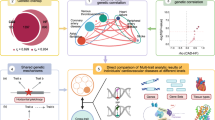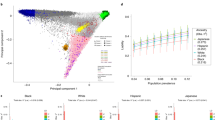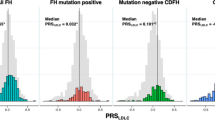Abstract
Linkage studies of complex diseases have so far had limited success in producing significant and replicable results, in part owing to genetic heterogeneity. We recently reported the results of a large genome-wide linkage scan for coronary artery disease (CAD) based on 1933 families. The greatest evidence for linkage was to a region of chromosome 2, with a logarithm of odds (LOD) score of 1.86, based on the non-parametric SALL statistic, which did not reach genome-wide significance (P>0.3). Inclusion of a covariate in linkage analysis can be a powerful method of accounting for disease heterogeneity. As CAD is a heterogeneous disease, we carried out a linkage analysis of chromosome 2 incorporating covariates. Increased evidence for linkage was found when hypercholesterolemia was considered (LOD score including covariate of 4.4) reaching genome-wide significance as assessed by simulation (P=0.04). Results showed that the original evidence for linkage was largely attributable to the subset of 108 non-hypercholesterolemic affected sibling pairs. In separate linkage analyses of subsets of hypercholesterolemic and non-hypercholesterolemic sibling pairs, the maximum LOD scores were 1.09 in the former group and 3.74 in the latter. This result illustrates the potential to increase the power of linkage analysis in the presence of heterogeneity by inclusion of covariates. This linked locus on chromosome 2 should now be investigated further to identify the gene(s) influencing risk of CAD in subjects with a normal level of total cholesterol. Candidate genes include the interleukin 1 cluster and two potential regulators of high-density lipoprotein cholesterol level, PLA2R1 and OSBPL6.
Similar content being viewed by others
Log in or create a free account to read this content
Gain free access to this article, as well as selected content from this journal and more on nature.com
or
References
The BHF Family Heart Study Research Group: A genomewide linkage study of 1933 families affected by premature coronary artery disease: The British Heart Foundation (BHF) Family Heart Study. Am J Hum Genet 2005; 77: 1011–1020.
Smith JD, Lusis JA : The allelic structure of common disease. Hum Mol Genet 2002; 11: 2455–2461.
Lusis JA, Mar R, Pajukanta P : Genetics of atherosclerosis. Ann Rev Genomics Hum Genet 2004; 5: 189–218.
Altmüller J, Palmer JL, Fischer G, Scherb H, Wjst M : Genomewide scans of complex human diseases: true linkage is hard to find. Am J Hum Genet 2001; 69: 936–950.
Philippe A, Martinez M, Guilloud-Bataille M et al: Genome-wide scan for autism susceptibility genes. Paris Autism Research International Sibpair Study. Hum Mol Genet 1999; 8: 805–812.
International Molecular Genetic Study of Autism Consortium: A full genome screen for autism with evidence for linkage to a region on chromosome 7q. Hum Mol Genet 1998; 7: 571–578.
Wang Q, Rao S, Shen GA et al: Premature myocardial infarction: novel susceptibility locus on chromosome 1P34-36 identified by genomewide linkage analysis. Am J Hum Genet 2004; 74: 262–271.
Goddard KAB, Whitte JS, Suarez BK, Catalona WJ, Olson JM : Model-free linkage analysis with covariates confirms linkage of prostate cancer to chromosomes 1 and 4. Am J Hum Genet 2001; 68: 1197–1206.
Schaid DJ, McDonnell SK, Thibodeau SN : Regression models for linkage heterogeneity applied to familial prostate cancer. Am J Hum Genet 2001; 68: 1189–1196.
Olson JM, Goddard KB, Durek DM : The amyloid precursor proteic locus and very-late-onset Alzheimer disease. Am J Hum Genet 2001; 69: 895–899.
Holmans P, Hamshere M, Hollingworth P et al: Genome screen for loci influencing age at onset and rate of decline in late-onset Alzheimer's disease. Am J Med Genet B Neuropsychiatr Genet 2005; 135: 24–32.
Holmans P, Zubenko GS, Crowe RR et al: Genomewide significant linkage to recurrent, early-onset major depressive disorder on chromosome 15q. Am J Hum Genet 2004; 74: 1154–1167.
Rice J : The role of meta-analysis in linkage studies of complex traits. Am J Med Genet (Neuropsychiatric genetics) 1997; 74: 112–114.
Holmans P : Detecting gene–gene interactions using affected sib pair analysis with covariates. Hum Hered 2002; 53: 92–102.
Gudbjartsson DF, Jonasson K, Frigge ML, Kong A : Allegro, a new computer program for multipoint linkage analysis. Nat Genet 2000; 25: 12–13.
StataCorp: Stata statistical software: Release 9. College station, TX: StataCorp LP, 2005.
Abecasis RG, Cherny SS, Cookson OW, Cardon RL : Merlin – Rapid analysis of dense genetic maps using sparse gene flow trees. Nat Genet 2002; 30: 97–101.
Kong A, Cox NJ : Allele-sharing models: LOD scores and accurate linkage tests. Am J Hum Genet 1997; 61: 1179–1188.
Risch N : Linkage strategies for genetically complex traits. II. The power of affected relative pairs. Am J Hum Genet 1990; 46: 229–241.
Olson JM, Cordell JH : Ascertainment bias in the estimation of sibling genetic risk parameters. Genet Epidemiol 2000; 18: 217–235.
Cordell JH, Olson JM : Correcting for ascertainment bias of relative-risk estimates obtained using affected-sib-pair linkage data. Genet Epidemiol 2000; 18: 307–321.
Pajukanta P, Cargill M, Viitanen L et al: Two loci on chromosomes 2 and X for premature coronary heart disease identified in early- and late-settlement populations of Finland. Am J Hum Genet 2000; 67: 1481–1493.
Farrall M, Green FR, Peden JF et al: Genomewide mapping of susceptibility to coronary artery disease identifies a novel replicated locus on chromosome 17. PLoS Genetics 2006; 2: e72.
Tall AR : Plasma high density lipoproteins. Metabolism and relationship to atherogenesis. J Clin Invest 1990; 86: 379–384.
Gordon DJ, Probstfield JL, Garrison RJ et al: High-density lipoprotein cholesterol and cardiovascular disease: Four prospective American studies. Circulation 1989; 79: 8–15.
Ross R : Atherosclerosis – an inflammatory disease. N Engl J Med 1999; 340: 115–125.
Spronk MHH, Van der Voort D, ten Cate H : Blood coagulation and the risk of atherothrombosis: a complex relationship. BMC Genet 2004; 2: 12.
Esmon TC : The interactions between inflammation and coagulation. Br J Haematol 2005; 131: 417–430.
Kornman SK : Interleukin1 genetics, infammatory mechanisms, and nutrigenetic opportunities to modulate diseases of aging. Am J Clin Nutr 2006; 83 (Suppl): 475S–483S.
Waehre T, Ynderstad A, Smith C et al: Increased expression of Interleukin-1 in coronary artery disease with downregulatory effects of HMG-CoA reductase inhibitors. Circulation 2004; 109: 1966–1972.
North KE, Martin LJ, Dyer T, Comuzzie AG, Williams JT : HDL cholesterol in females in the Framingham Heart Study is linked to a region of chromosome 2q. BMC Genet 2003; 4 (Suppl 1): S98.
Arya R, Lehman D, Hunt JK et al: Evidence for bivariate linkage of obesity and HDL-C levels in the Framingham Heart Study. BMC Genet 2003; 4 (Suppl1): S52.
Tietge UJF, Maugeais C, Lund-Katz S, Grass D, deBeer FC, Rader DJ : Human secretory phospholipase A2 mediates decreased plasma levels of HDL cholesterol and ApoA-I in response to inflammation in human ApoA-I transgenic mice. Arterioscler Thromb Vasc Biol 2002; 22: 1213–1218.
Petrovic N, Crove C, Langton PE, Misso NLA, Thompson PJ : A simple assay for a human serum phospholipase A2 that is associated with high density lipoproteins. J Lipid Res 2001; 42: 1706–1718.
Kugiyama K, Ota Y, Takazoe K et al: Circulating levels of secretory type II phospholipase A2 predict coronary events in patients with coronary artery disease. Circulation 1999; 100: 1280–1284.
Kugiyama K, Ota Y, Kawano H et al: Increase in plasma levels of secretory type II phospholipase A2 in patients with coronary spastic angina. Cardivasc Res 2000; 47: 159–165.
Kugiyama K, Ota Y, Sugiyama S et al: Prognostic value of plasma levels of secretory type II phospholipase A2 in patients with unstable angina pectoris. Am J Cardiol 2000; 86: 718–722.
Rimner A, Makdessi AS, Sweidan H et al: Relevance and mechanism of oxysterol stereospecifity in coronary artery disease. Free Radic Biol Med 2005; 38: 535–544.
Roberts SB, Maclean CJ, Neale MC, Eaves LJ, Kendler KS : Replication of linkage studies of complex traits: an examination of variation in location estimates. Am J Hum Genet 1999; 65: 876–884.
Acknowledgements
The Family Heart Study was supported by a program grant from the British Heart Foundation (RG2000010). We thank all families who participated in the study, as well as staff in hospitals and general practices throughout the UK who helped in the collection of DNA samples and validation of medical records.
Author information
Authors and Affiliations
Consortia
Corresponding author
Additional information
The BHF family heart study research group:
Leeds
Stephen Ball, Anthony Balmforth, Jenny Barrett, Lynne Barthorpe, Timothy Bishop, Natalie Burtonwood, Richard Cuthbert, Micha Dorsch, Nigel Durham, Stacey Ellis, Claire Forest, Joanne Fox, Alistair Hall, Vera Hall, Beryl Jackson, Natasha Kelly, Richard Lawrance, Azhar Maqbool, Samantha Mason, Lynne Midgley, Christine Morrell, Jérémie Nsengimana, Julia Oldham, Sarah Pickett, Mark Platts, Natalie Pleasants, Elizabeth Rennie, Adrian Smith, Samantha Thompson, Peter Tooze, Kevin Walters and Nadira Yuldasheva.
Leicester
Sue Adams, Claire Bodycote, Peter Braund, Paul Burton, Jenny-Rebecca Clemitson, Pat de Souza, Rick Dixon, Julie Faulkes, Laura Hopwood, Andrea Koekemoer, Elaine Logtens, Massimo Mangino, Jenny Ogleby, Stuart Raleigh, Cathy Ridge, Nilesh Samani, Katrina Scurrah, Nuala Sheehan, Ravi Singh and Julian Stribling.
Rights and permissions
About this article
Cite this article
Nsengimana, J., Samani, N., Hall, A. et al. Enhanced linkage of a locus on chromosome 2 to premature coronary artery disease in the absence of hypercholesterolemia. Eur J Hum Genet 15, 313–319 (2007). https://doi.org/10.1038/sj.ejhg.5201752
Received:
Revised:
Accepted:
Published:
Issue date:
DOI: https://doi.org/10.1038/sj.ejhg.5201752
Keywords
This article is cited by
-
The long noncoding RNA CHROME regulates cholesterol homeostasis in primates
Nature Metabolism (2018)
-
ChIP-seq in steatohepatitis and normal liver tissue identifies candidate disease mechanisms related to progression to cancer
BMC Medical Genomics (2013)
-
An evaluation of inflammatory gene polymorphisms in sibships discordant for premature coronary artery disease: the GRACE-IMMUNE study
BMC Medicine (2010)



